2023 HYUNDAI IONIQ 6 flat tire
[x] Cancel search: flat tirePage 514 of 582
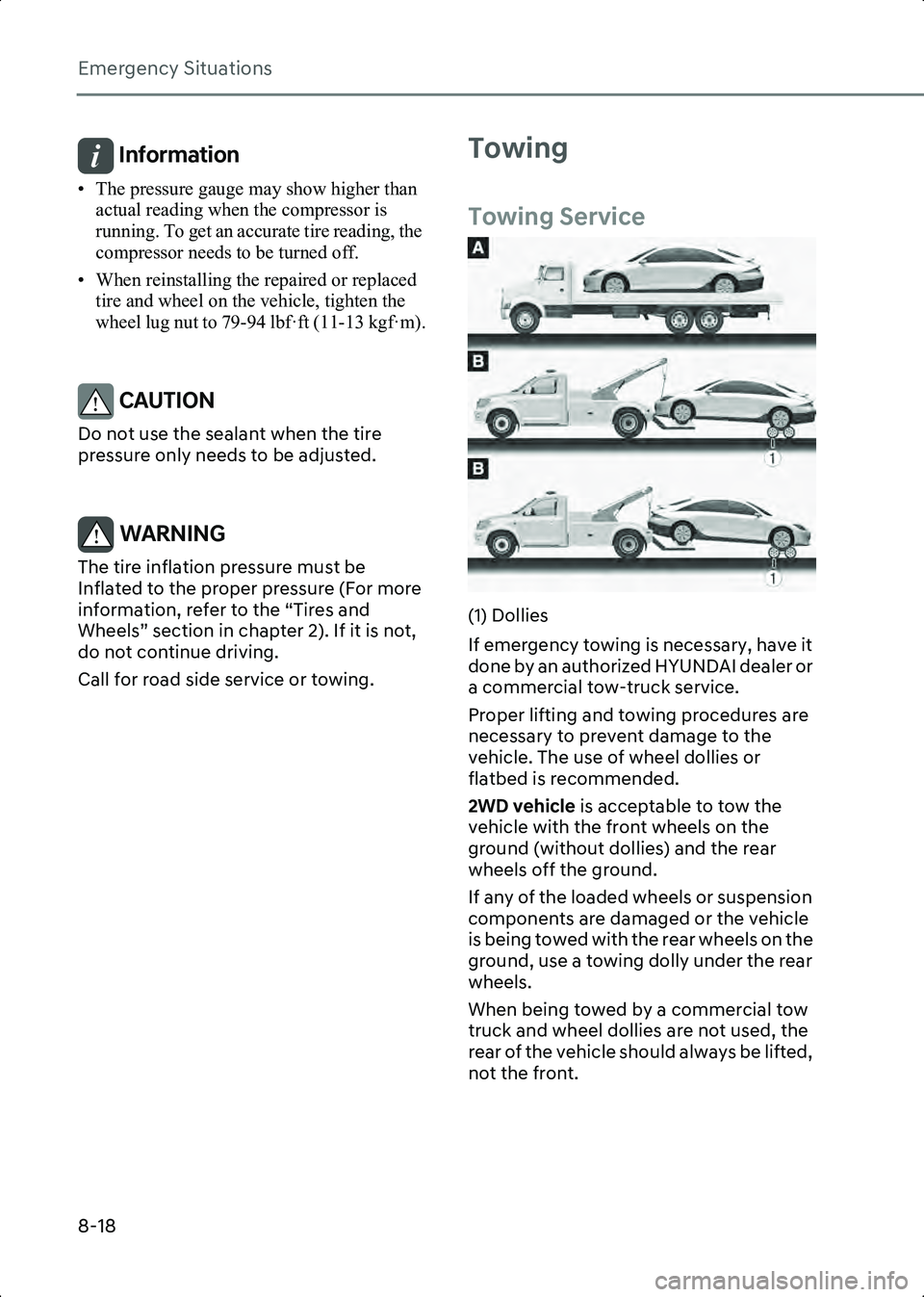
Emergency Situations
8-18
Information • The pressure gauge may show higher than actual reading when the compressor is
running. To get an accurate tire reading, the
compressor needs to be turned off.
• When reinstalling the repaired or replaced tire and wheel on the vehicle, tighten the
wheel lug nut to 79-94 lbf·ft (11-13 kgf·m).
CAUTION Do not use the sealant when the tire
pressure only needs to be adjusted.
WARNING The tire inflation pressure must be
Inflated to the proper pressure (For more
information, refer to the “Tires and
Wheels” section in chapter 2). If it is not,
do not continue driving.
Call for road side service or towing.
Towing
Towing Service
B8002701(1) Dollies
If emergency towing is necessary, have it
done by an authorized HYUNDAI dealer or
a commercial tow-truck service.
Proper lifting and towing procedures are
necessary to prevent damage to the
vehicle. The use of wheel dollies or
flatbed is recommended.
2WD vehicle is acceptable to tow the
vehicle with the front wheels on the
ground (without dollies) and the rear
wheels off the ground.
If any of the loaded wheels or suspension
components are damaged or the vehicle
is being towed with the rear wheels on the
ground, use a towing dolly under the rear
wheels.
When being towed by a commercial tow
truck and wheel dollies are not used, the
rear of the vehicle should always be lifted,
not the front.
Hyundai_CE_en_US.book Page 18
Page 518 of 582

9
For Best Battery Service ............................................................................................ 9-18
Battery Capacity Label ............................................................................................... 9-19
Battery Recharging .................................................................................................... 9-19
Reset Items ................................................................................................................ 9-20
Tires and Wheels ........................................................................................................... 9-20 Tire Care ...................................................................................................................... 9-21
Recommended Cold Tire Inflation Pressures........................................................... 9-21
Check Tire Inflation Pressure.....................................................................................9-22
Tire Rotation ...............................................................................................................9-22
Wheel Alignment and Tire Balance .......................................................................... 9-23
Tire Replacement ...................................................................................................... 9-23
Wheel Replacement .................................................................................................. 9-24
Tire Traction ............................................................................................................... 9-24
Tire Maintenance....................................................................................................... 9-24
Tire Sidewall Labeling ............................................................................................... 9-24
Tire Terminology and Definitions .............................................................................. 9-27
All Season Tires .......................................................................................................... 9-30
Summer Tires ............................................................................................................. 9-30
Snow Tires .................................................................................................................. 9-30
Radial-Ply Tires .......................................................................................................... 9-30
Low Aspect Ratio Tires ............................................................................................... 9-31
Fuses .............................................................................................................................. 9-32
Blade type...................................................................................................................... 9-32
Cartridge type ............................................................................................................... 9-32
Multi type....................................................................................................................... 9-32 Instrument Panel Fuse Replacement....................................................................... 9-33
Motor compartment.................................................................................................. 9-33
Motor Compartment Panel Fuse Replacement ...................................................... 9-33
Fuse/Relay Panel Description .................................................................................. 9-35
Light Bulbs ..................................................................................................................... 9-43 Headlight, Parking Light, Turn Signal Light, Daytime Running Light (DRL)
Replacement.............................................................................................................. 9-44
Side Repeater Light Replacement ........................................................................... 9-44Rear Combination Light Replacement .................................................................... 9-44
High Mounted Stop Light Replacement .................................................................. 9-45
License Plate Light Replacement ............................................................................. 9-45
Front Trunk Light Replacement ............................................................................... 9-45
Hyundai_CE_en_US.book Page 2
Page 522 of 582
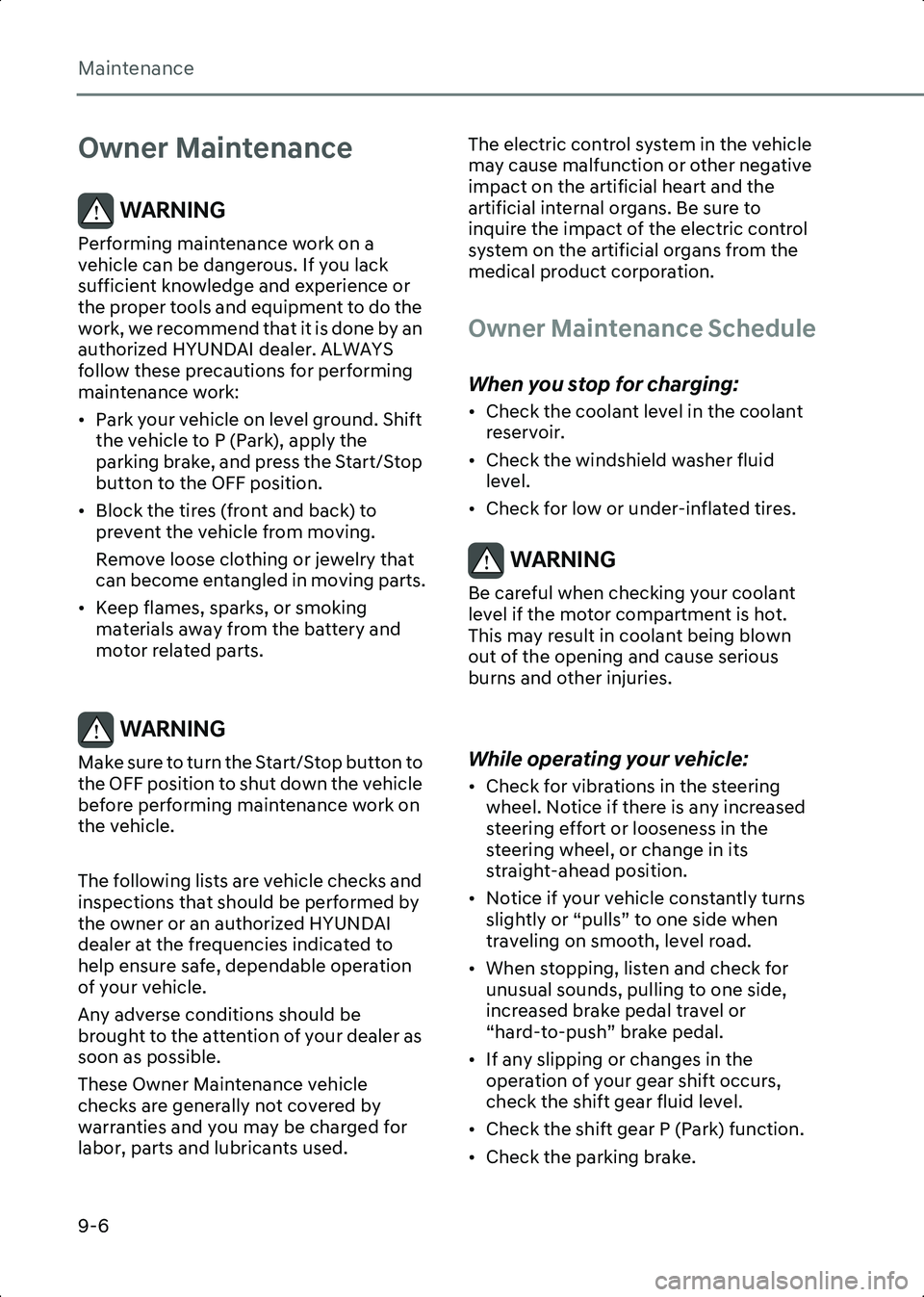
Maintenance
9-6
Owner Maintenance
WARNING Performing maintenance work on a
vehicle can be dangerous. If you lack
sufficient knowledge and experience or
the proper tools and equipment to do the
work, we recommend that it is done by an
authorized HYUNDAI dealer. ALWAYS
follow these precautions for performing
maintenance work:
• Park your vehicle on level ground. Shift the vehicle to P (Park), apply the
parking brake, and press the Start/Stop
button to the OFF position.
• Block the tires (front and back) to prevent the vehicle from moving.
Remove loose clothing or jewelry that
can become entangled in moving parts.
• Keep flames, sparks, or smoking materials away from the battery and
motor related parts.
WARNING Make sure to turn the Start/Stop button to
the OFF position to shut down the vehicle
before performing maintenance work on
the vehicle.
The following lists are vehicle checks and
inspections that should be performed by
the owner or an authorized HYUNDAI
dealer at the frequencies indicated to
help ensure safe, dependable operation
of your vehicle.
Any adverse conditions should be
brought to the attention of your dealer as
soon as possible.
These Owner Maintenance vehicle
checks are generally not covered by
warranties and you may be charged for
labor, parts and lubricants used. The electric control system in the vehicle
may cause malfunction or other negative
impact on the artificial heart and the
artificial internal organs. Be sure to
inquire the impact of the electric control
system on the artificial organs from the
medical product corporation.
Owner Maintenance Schedule
When you stop for charging:
• Check the coolant level in the coolant
reservoir.
• Check the windshield washer fluid level.
• Check for low or under-inflated tires.
WARNING Be careful when checking your coolant
level if the motor compartment is hot.
This may result in coolant being blown
out of the opening and cause serious
burns and other injuries.
While operating your vehicle:
• Check for vibrations in the steering wheel. Notice if there is any increased
steering effort or looseness in the
steering wheel, or change in its
straight-ahead position.
• Notice if your vehicle constantly turns slightly or “pulls” to one side when
traveling on smooth, level road.
• When stopping, listen and check for unusual sounds, pulling to one side,
increased brake pedal travel or
“hard-to-push” brake pedal.
• If any slipping or changes in the operation of your gear shift occurs,
check the shift gear fluid level.
• Check the shift gear P (Park) function.
• Check the parking brake.
Hyundai_CE_en_US.book Page 6
Page 523 of 582

9
9-7
• Check for fluid leaks under your vehicle (water dripping from the air
conditioning system during or after use
is normal).
At least monthly:
• Check coolant level in the coolant reservoir.
• Check the operation of all exterior lights, including the stoplights, turn
signals and hazard warning flashers.
• Check the inflation pressures of all tires including the spare for tires that are
worn, show uneven wear, or are
damaged.
• Check for loose wheel lug nuts.
At least twice a year: (for example,
every Spring and Autumn)
• Check radiator, heater and air conditioning hoses for leaks or
damage.
• Check windshield washer spray and wiper operation. Clean wiper blades
with a clean cloth dampened with
washer fluid.
• Check headlight alignment.
• Check the seat belts for wear and function.
At least once a year:
• Clean body and door drain holes.
• Lubricate door hinges and hood hinges.
• Lubricate door and hood locks and latches.
• Lubricate door rubber weather strips.
• Check the air conditioning system.
• Inspect and lubricate shift gear linkage and controls.
• Clean the battery (12 V) and terminals.
• Check the brake fluid level.
Scheduled Maintenance
Services
Follow Normal Maintenance Schedule if
the vehicle is usually operated where
none of the following conditions apply. If
any of the following conditions apply, you
must follow the Maintenance Under
Severe Usage Conditions.
• Repeated driving short distance of less than 5 mi. (8 km) in normal temperature
or less than 10 mi. (16 km) in freezing
temperature
• Driving on rough, dusty, muddy, unpaved, graveled or salt-spread roads
• Driving in areas using salt or other corrosive materials or in very cold
weather
• Driving in heavy dust condition
• Driving in heavy traffic area with the ambient temperature higher than 90 ºF
(32 ºC) while consuming more than 50%
of electric energy.
• Driving on uphill, downhill, or mountain roads repeatedly
• Towing a trailer or using a camper, or driving with loads on the roof
• Driving as a patrol car, taxi, other commercial use or vehicle towing
• Frequently driving under high speed or rapid acceleration/deceleration
• Frequently driving in stop-and-go conditions
If your vehicle is operated under the
above conditions, you should inspect,
replace or refill more frequently than the
following Normal Maintenance Schedule.
After the periods or distance shown in the
chart, continue to follow the prescribed
maintenance intervals.
Hyundai_CE_en_US.book Page 7
Page 536 of 582

Maintenance
9-20
Information
An inappropriately disposed battery can be
harmful to the environment and human health.
Dispose of the battery according to your local
law(s) or regulation.
Reset Items
The following items may need to be reset
after the battery has been discharged or
the battery has been disconnected:
• Drive info/After Recharging/Accumulated info (items in
View modes) (refer to chapter 4)
• Integrated Memory System (refer to chapter 5)
• Power Windows (refer to chapter 5)
• Wide Sunroof (if equipped) (refer to chapter 5)
• Power Trunk (refer to chapter 5)
• Automatic Climate Control System (refer to chapter 5)
• Clock (refer to the Infotainment system manual)
• Infotainment System (refer to the Infotainment system manual)
Tires and Wheels
WARNING Tire failure may cause loss of vehicle
control resulting in an accident. To
reduce risk of SERIOUS INJURY or
DEATH, take the following
precautions:
• Inspect your tires monthly for proper inflation as well as wear and
damage.
• The recommended cold tire pressure for your vehicle can be
found in this manual and on the tire
label located on the driver’s side
center pillar. Always use a tire
pressure gauge to measure tire
pressure. Tires with too much or
too little pressure wear unevenly
causing poor handling.
• Check the pressure of the spare every time you check the pressure
of the other tires on your vehicle.
• Replace tires that are worn, show uneven wear, or are damaged.
Worn tires can cause loss of braking
effectiveness, steering control, or
traction.
• ALWAYS replace tires with the same size, type, construction and
tread pattern as each tire that was
originally supplied with this vehicle.
Using tires and wheels other than
the recommended sizes could
cause unusual handling
characteristics, poor vehicle
control, or negatively affect your
vehicle’s Anti-Lock Brake System
(ABS) resulting in a serious
accident.
Hyundai_CE_en_US.book Page 20
Page 537 of 582
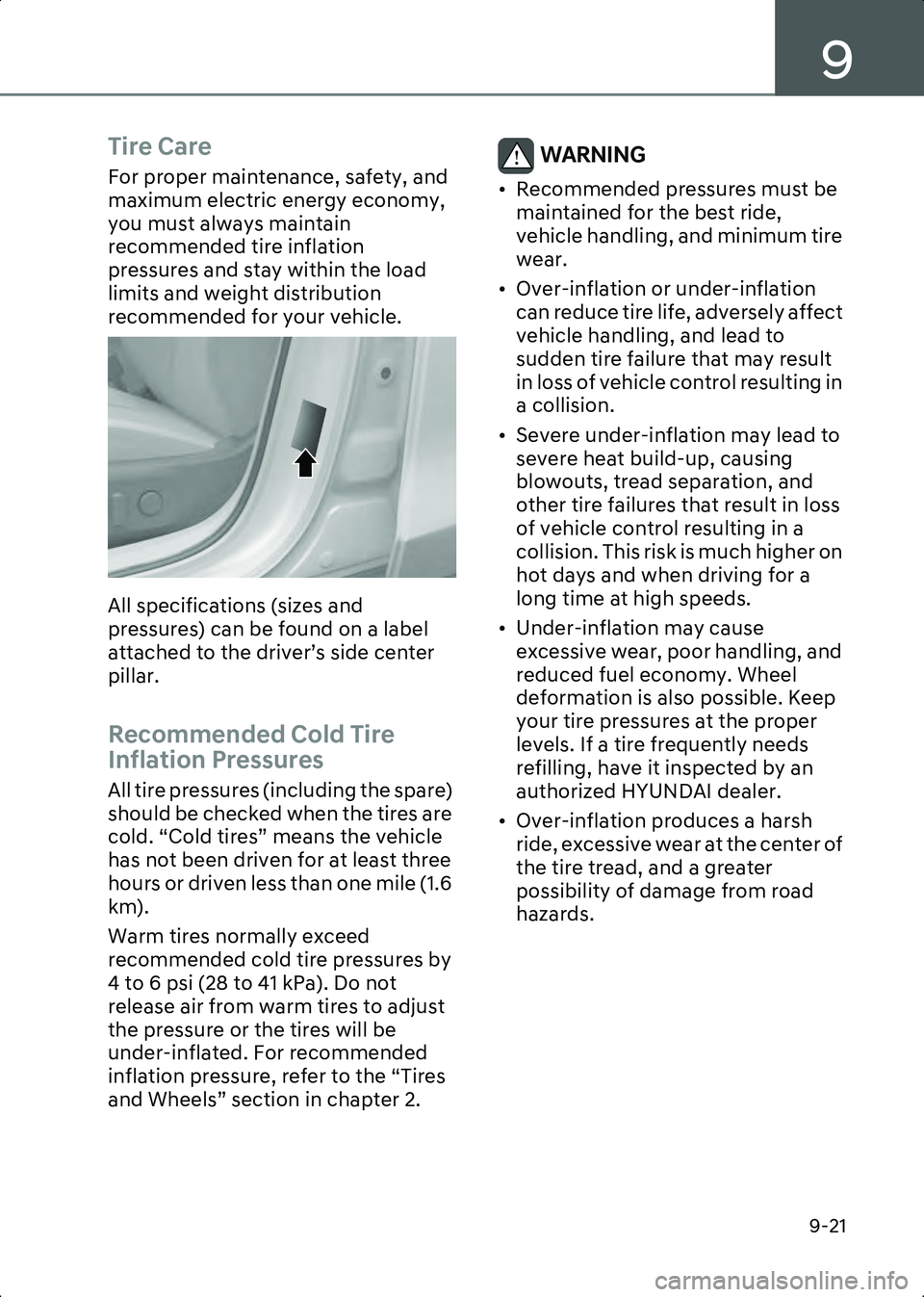
9
9-21
Tire Care
For proper maintenance, safety, and
maximum electric energy economy,
you must always maintain
recommended tire inflation
pressures and stay within the load
limits and weight distribution
recommended for your vehicle.
OJK010021
All specifications (sizes and
pressures) can be found on a label
attached to the driver’s side center
pillar.
Recommended Cold Tire
Inflation Pressures
All tire pressures (including the spare)
should be checked when the tires are
cold. “Cold tires” means the vehicle
has not been driven for at least three
hours or driven less than one mile (1.6
km).
Warm tires normally exceed
recommended cold tire pressures by
4 to 6 psi (28 to 41 kPa). Do not
release air from warm tires to adjust
the pressure or the tires will be
under-inflated. For recommended
inflation pressure, refer to the “Tires
and Wheels” section in chapter 2.
WARNING • Recommended pressures must be maintained for the best ride,
vehicle handling, and minimum tire
wear.
• Over-inflation or under-inflation can reduce tire life, adversely affect
vehicle handling, and lead to
sudden tire failure that may result
in loss of vehicle control resulting in
a collision.
• Severe under-inflation may lead to severe heat build-up, causing
blowouts, tread separation, and
other tire failures that result in loss
of vehicle control resulting in a
collision. This risk is much higher on
hot days and when driving for a
long time at high speeds.
• Under-inflation may cause excessive wear, poor handling, and
reduced fuel economy. Wheel
deformation is also possible. Keep
your tire pressures at the proper
levels. If a tire frequently needs
refilling, have it inspected by an
authorized HYUNDAI dealer.
• Over-inflation produces a harsh ride, excessive wear at the center of
the tire tread, and a greater
possibility of damage from road
hazards.
Hyundai_CE_en_US.book Page 21
Page 538 of 582
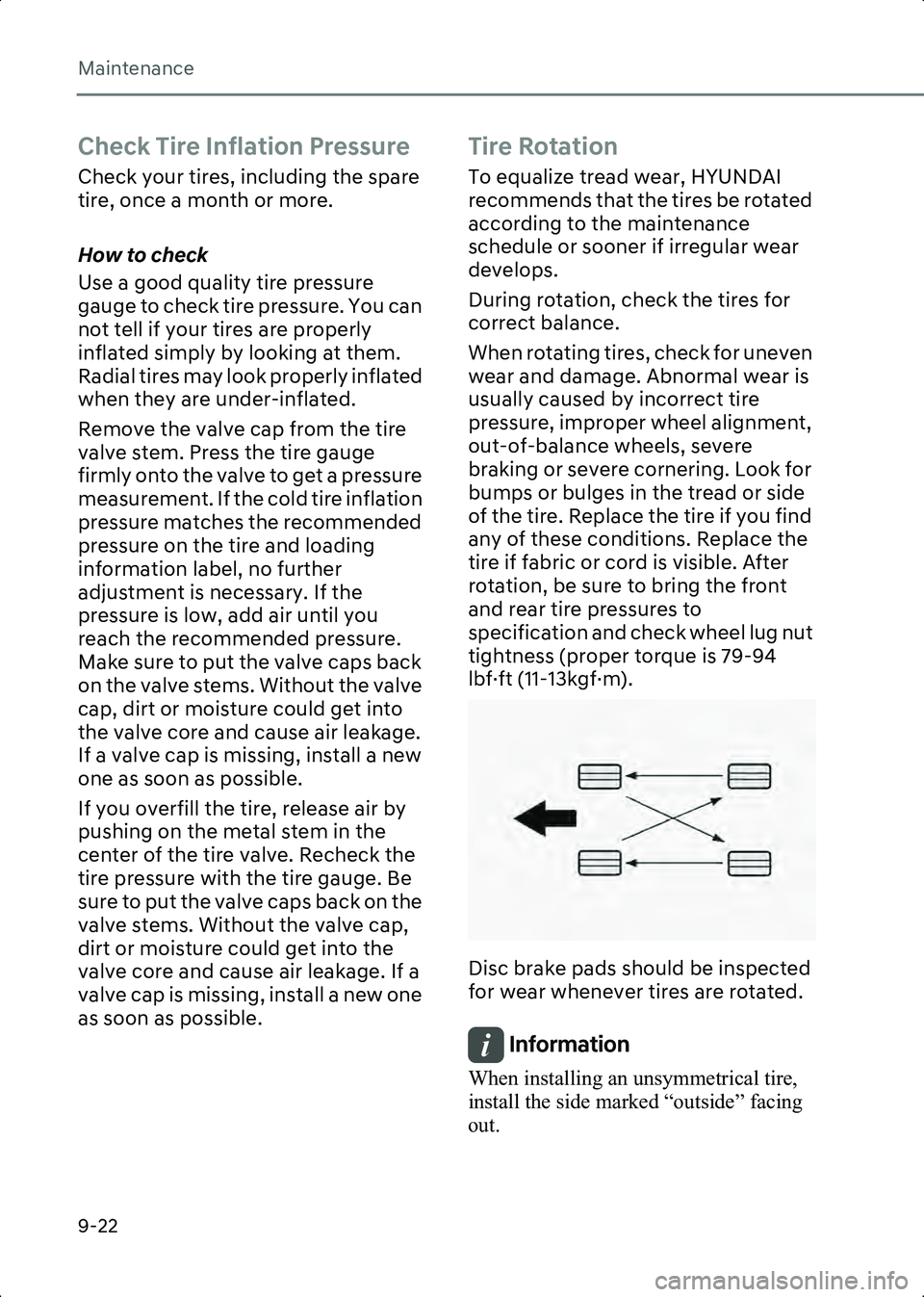
Maintenance
9-22
Check Tire Inflation Pressure
Check your tires, including the spare
tire, once a month or more.
How to check
Use a good quality tire pressure
gauge to check tire pressure. You can
not tell if your tires are properly
inflated simply by looking at them.
Radial tires may look properly inflated
when they are under-inflated.
Remove the valve cap from the tire
valve stem. Press the tire gauge
firmly onto the valve to get a pressure
measurement. If the cold tire inflation
pressure matches the recommended
pressure on the tire and loading
information label, no further
adjustment is necessary. If the
pressure is low, add air until you
reach the recommended pressure.
Make sure to put the valve caps back
on the valve stems. Without the valve
cap, dirt or moisture could get into
the valve core and cause air leakage.
If a valve cap is missing, install a new
one as soon as possible.
If you overfill the tire, release air by
pushing on the metal stem in the
center of the tire valve. Recheck the
tire pressure with the tire gauge. Be
sure to put the valve caps back on the
valve stems. Without the valve cap,
dirt or moisture could get into the
valve core and cause air leakage. If a
valve cap is missing, install a new one
as soon as possible.
Tire Rotation
To equalize tread wear, HYUNDAI
recommends that the tires be rotated
according to the maintenance
schedule or sooner if irregular wear
develops.
During rotation, check the tires for
correct balance.
When rotating tires, check for uneven
wear and damage. Abnormal wear is
usually caused by incorrect tire
pressure, improper wheel alignment,
out-of-balance wheels, severe
braking or severe cornering. Look for
bumps or bulges in the tread or side
of the tire. Replace the tire if you find
any of these conditions. Replace the
tire if fabric or cord is visible. After
rotation, be sure to bring the front
and rear tire pressures to
specification and check wheel lug nut
tightness (proper torque is 79-94
lbf·ft (11-13kgf·m).
B9005001
Disc brake pads should be inspected
for wear whenever tires are rotated.
Information When installing an unsymmetrical tire,
install the side marked “outside” facing
out.
Hyundai_CE_en_US.book Page 22
Page 540 of 582
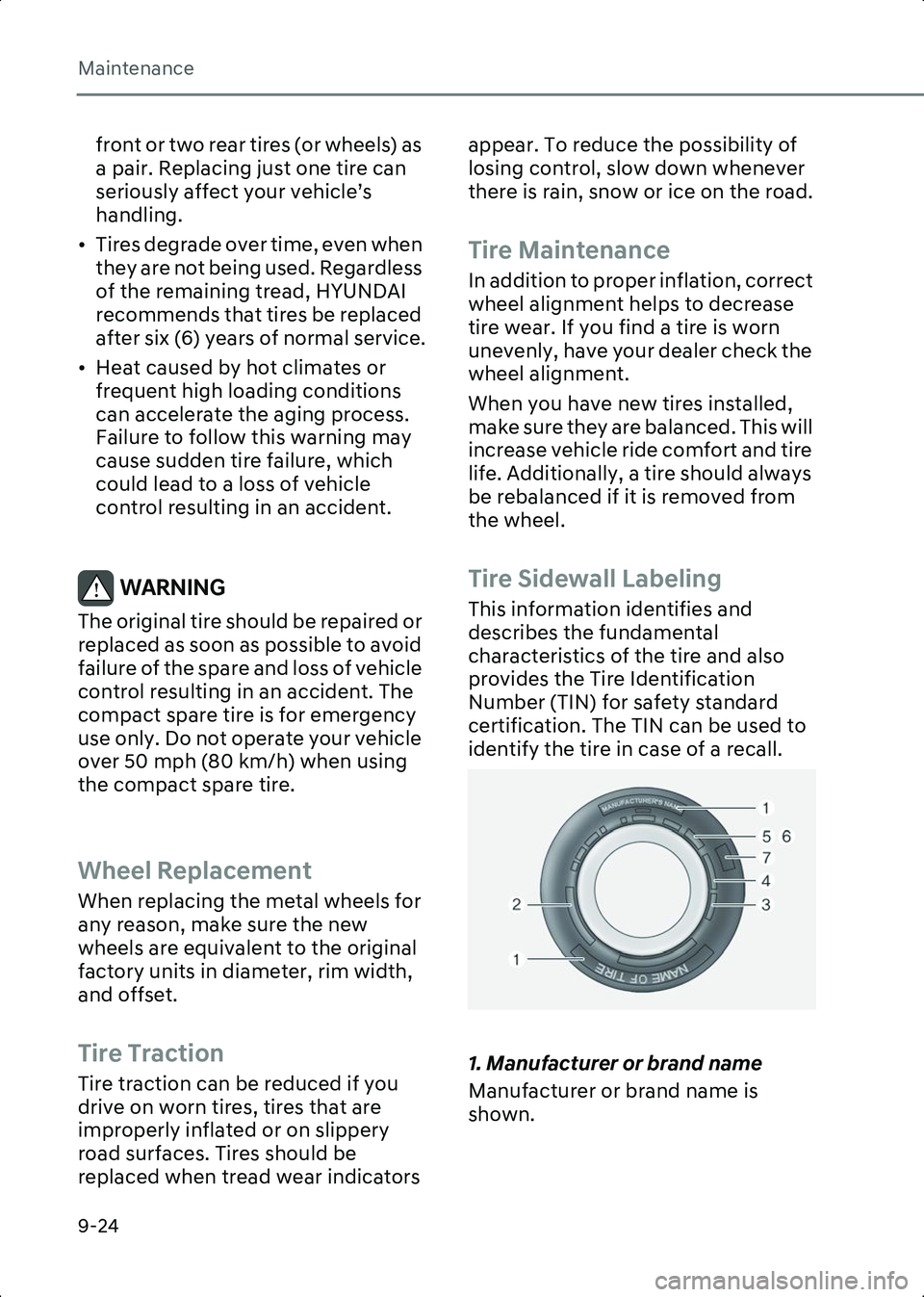
Maintenance
9-24
front or two rear tires (or wheels) as
a pair. Replacing just one tire can
seriously affect your vehicle’s
handling.
• Tires degrade over time, even when they are not being used. Regardless
of the remaining tread, HYUNDAI
recommends that tires be replaced
after six (6) years of normal service.
• Heat caused by hot climates or frequent high loading conditions
can accelerate the aging process.
Failure to follow this warning may
cause sudden tire failure, which
could lead to a loss of vehicle
control resulting in an accident.
WARNING The original tire should be repaired or
replaced as soon as possible to avoid
failure of the spare and loss of vehicle
control resulting in an accident. The
compact spare tire is for emergency
use only. Do not operate your vehicle
over 50 mph (80 km/h) when using
the compact spare tire.
Wheel Replacement
When replacing the metal wheels for
any reason, make sure the new
wheels are equivalent to the original
factory units in diameter, rim width,
and offset.
Tire Traction
Tire traction can be reduced if you
drive on worn tires, tires that are
improperly inflated or on slippery
road surfaces. Tires should be
replaced when tread wear indicators appear. To reduce the possibility of
losing control, slow down whenever
there is rain, snow or ice on the road.
Tire Maintenance
In addition to proper inflation, correct
wheel alignment helps to decrease
tire wear. If you find a tire is worn
unevenly, have your dealer check the
wheel alignment.
When you have new tires installed,
make sure they are balanced. This will
increase vehicle ride comfort and tire
life. Additionally, a tire should always
be rebalanced if it is removed from
the wheel.
Tire Sidewall Labeling
This information identifies and
describes the fundamental
characteristics of the tire and also
provides the Tire Identification
Number (TIN) for safety standard
certification. The TIN can be used to
identify the tire in case of a recall.
B9005401
1. Manufacturer or brand name
Manufacturer or brand name is
shown.
Hyundai_CE_en_US.book Page 24